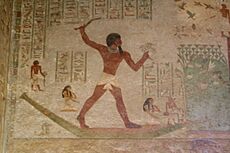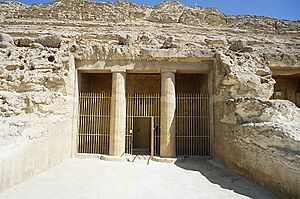Khnumhotep II facts for kids
Quick facts for kids Khnumhotep IINomarch of the 16th nome of Upper Egypt |
|
|---|---|

Khnumhotep II depicted while hunting waterfowl in the marshes
|
|
| Predecessor | Nakht or Netjernakht |
| Successor | Khnumhotep IV |
| Dynasty | 12th Dynasty |
| Pharaoh | Amenemhat II, Senusret II |
| Father | Neheri |
| Mother | Baqet |
| Wife | Khety; Tjat |
| Children | Nakht, Khnumhotep IV, Khnumhotep III, Neheri, and others |
| Burial | Beni Hasan tomb 3 (BH3) |
Khnumhotep II was an important ancient Egyptian leader. He was known as the Great Chief of the Oryx nome, which was a region in Upper Egypt. He lived during the time of pharaohs Amenemhat II and Senusret II, around 2000 BCE. Khnumhotep II is famous today because of his amazing tomb at Beni Hasan and the beautiful pictures inside it.
Contents
Khnumhotep II: An Ancient Egyptian Leader
Who Was Khnumhotep II?
Khnumhotep II was part of a powerful family of leaders and officials. This family was likely started by his grandfather, Khnumhotep I. Khnumhotep II held many important jobs. He was a hereditary prince and count, which meant he was born into a noble family. He was also a royal sealer and a sole friend of the pharaoh.
He was also the overseer of the Eastern Desert. He held this job for many years, from the time of Pharaoh Amenemhat II to Senusret II. Like many leaders of his time, he also had some religious duties as a priest.
Khnumhotep's Family and Life
Khnumhotep's life story is written on the walls of his tomb. It tells us that he even traveled to faraway places like Byblos and Punt.
His mother was Baqet, and his father was an official named Neheri. Khnumhotep II had two wives. His main wife was Khety. She was the daughter of the leader of a nearby region. Khety also had many important titles, like daughter of a governor and lady of the house. She was also a priestess for the goddesses Hathor and Pakhet.
Khnumhotep's second wife was Tjat. She had fewer titles, but one special one was sealer. This was unusual for a woman at that time. Some historians think his marriage to Khety was arranged for political reasons, while Tjat might have been someone he truly loved.
His Children and Their Futures
Khnumhotep II had several children with his wives:
- Nakht became the leader of his maternal grandfather's region.
- Khnumhotep IV followed his father as the leader of the 16th nome.
- Khnumhotep III went to work for the pharaoh at the royal court. He became a very important official, first as a high steward and later as a vizier. A vizier was like a prime minister.
- Neheri was buried in a small tomb near his father's.
- Another son became a "mayor" in a neighboring region.
You can learn more about Khnumhotep's family tree by looking up "Nomarchs of the Oryx nome".
Discovering Khnumhotep's Tomb (BH3)
Khnumhotep II was buried in Tomb 3 (BH3) at Beni Hasan. This is one of the most famous tombs in the area. In ancient times, a special path led to the tomb.
The tomb has a front area with columns and a small open courtyard. The courtyard likely had mud-brick walls around it. The entrance to the tomb is behind the columns. The ceiling of this front area is curved like a barrel. Around the doorway, there are writings that list special days for funeral offerings. These writings also show Khnumhotep II's name and titles.
What the Tomb Looks Like
The main room of the tomb, called the chapel, is lower than the outside courtyard. You walk down three steps to enter it. This main room is cut into the cliff and has four columns. These columns hold up a ceiling that looks like three curved barrel shapes. The ceiling is painted with patterns that might look like a tent.
There are also two large shafts cut into the floor. These shafts lead to the actual burial chambers. The only light in this room would have come from the doorway. There used to be a door that could close the tomb off from the outside.
At the back of the main room, there is a small shrine. A step leads up to it. Long ago, there was a statue of Khnumhotep II sitting here, but it has been cut away. On the walls, you can see pictures of Khnumhotep's important officials and workers. It was like a smaller version of the pharaoh's royal court.
Stories on the Walls
The main room has Khnumhotep II's autobiography written on its walls. It tells about his life, his family, and how close his family was to the royal family. It also describes his good character and asks visitors to make offerings to him.
On the west wall, there are scenes showing preparations for the funeral. These pictures also show boat trips that connect Khnumhotep II to the god Osiris. The boats are shown traveling south to Abydos and then returning north. These scenes were meant to help the tomb owner be reborn in the afterlife.
On the north wall, there is a large picture of Khnumhotep II receiving offerings of animals and birds. On the other side of this wall, he is shown hunting in the desert with a bow. This scene might show Khnumhotep II acting like a king, controlling the wild desert.
The east wall has the entrance to the shrine. It also has two large pictures of Khnumhotep II hunting in the marshes. In one, he is harpooning fish. In the other, he is hunting birds with a throwing stick. These marsh hunting scenes were believed to protect the person in the afterlife. Below him, there are pictures of people fishing and fighting boatmen. All these pictures on this wall show Khnumhotep II's never-ending renewal.
The south wall of the tomb shows a celebration of a meal for Khnumhotep II and his wife Khety. Khnumhotep is shown sitting in front of a table full of offerings. He holds a flail, which was a symbol of royalty. Khety is also shown sitting in front of a full offering table, taking part in her husband's meal.
The shrine area has a smaller version of the offering cult. Placing statues inside the chapel itself was a new art style that appeared in tombs during the Middle Kingdom.
The Famous Aamu Procession
What makes this tomb truly special is a famous scene showing a group called the Aamu. These were nomadic traders from West Asia. They are sometimes thought to be early Hyksos people. The group, led by a man named Absha, is shown bringing offerings to Khnumhotep II. Even though the picture shows fifteen people, the writing next to it says there were 37 people in the group.



